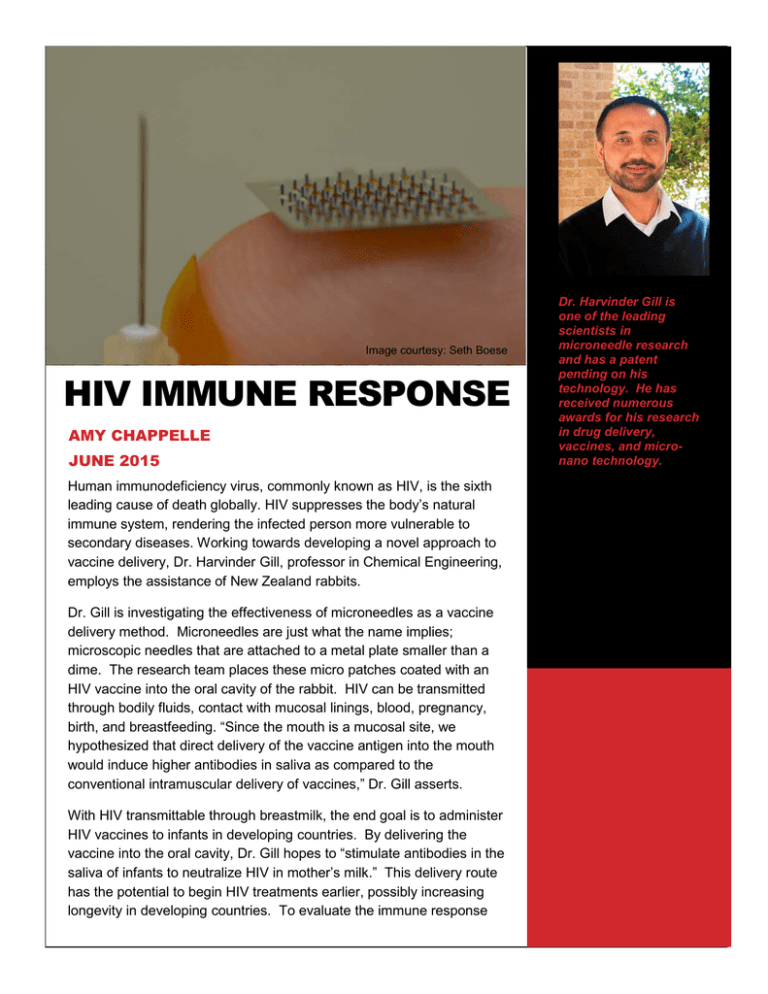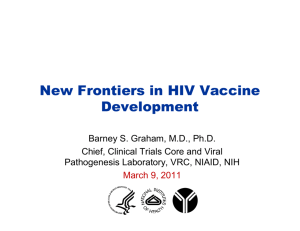HIV IMMUNE RESPONSE
advertisement

Image courtesy: Seth Boese HIV IMMUNE RESPONSE AMY CHAPPELLE JUNE 2015 Human immunodeficiency virus, commonly known as HIV, is the sixth leading cause of death globally. HIV suppresses the body’s natural immune system, rendering the infected person more vulnerable to secondary diseases. Working towards developing a novel approach to vaccine delivery, Dr. Harvinder Gill, professor in Chemical Engineering, employs the assistance of New Zealand rabbits. Dr. Gill is investigating the effectiveness of microneedles as a vaccine delivery method. Microneedles are just what the name implies; microscopic needles that are attached to a metal plate smaller than a dime. The research team places these micro patches coated with an HIV vaccine into the oral cavity of the rabbit. HIV can be transmitted through bodily fluids, contact with mucosal linings, blood, pregnancy, birth, and breastfeeding. “Since the mouth is a mucosal site, we hypothesized that direct delivery of the vaccine antigen into the mouth would induce higher antibodies in saliva as compared to the conventional intramuscular delivery of vaccines,” Dr. Gill asserts. With HIV transmittable through breastmilk, the end goal is to administer HIV vaccines to infants in developing countries. By delivering the vaccine into the oral cavity, Dr. Gill hopes to “stimulate antibodies in the saliva of infants to neutralize HIV in mother’s milk.” This delivery route has the potential to begin HIV treatments earlier, possibly increasing longevity in developing countries. To evaluate the immune response Dr. Harvinder Gill is one of the leading scientists in microneedle research and has a patent pending on his technology. He has received numerous awards for his research in drug delivery, vaccines, and micronano technology. induced by the microneedles, Dr. Gill is collecting numerous body fluid samples from the research rabbits. He hopes to see the body creating neutralizing antibodies against the HIV virus. These specific antibodies “would bind to the HIV, rendering it incapable of infecting the individual,” Dr. Gill explains. Microneedles are more efficient and allow for easier application of vaccines and medications without the fear, pain, and cost associated with traditional hypodermic needles. Instead of requiring trained medical personnel to administer the vaccine, microneedles need minimal training for accurate application. This transition to human medicine could “facilitate mass vaccination by simplifying delivery logistics and reducing cost of storage and transportation,” Dr. Gill explains. This approach could pave the way for developing countries to receive and administer vaccines to otherwise inaccessible towns, tribes, and villages. Currently, there is no vaccine or cure for HIV/AIDS, but research continues on its development by investigating immune responses to HIV vaccines. HIV has the tendency to mutate rapidly, which creates difficulty in developing a blanket preventative vaccine. Dr. Gill and his research team hopes that the introduction of microneedles as a delivery route will increase the effectiveness of administering the HIV vaccine and preventing further infections.

